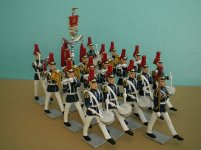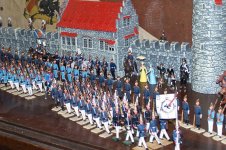Wolfgang_UK
Staff Sergeant
- Joined
- Dec 5, 2009
- Messages
- 836
Also in the same vein as the last post, here is Hiriart set 1336 WORLD WAR I WESTFALISHE JAEGER BATTALION, 1914. It is unusual in that very few Hiriart sets are made with the figures running. I wonder where Westfalishe is located in Germany?
Once again beautifull figures you are shareing with us - Thank you very much indeed!!!
The former capital of the prussian province of "Westfalen" was the city of Münster. It served as a garrison for many decades. As Brad rightly wrote after world war two Westfalen and parts of the prussian province of the Rhineland where united to form the new Bundesland (Federal County) of Nordrhein-Westfalen in post war Germany.
Düsseldorf became the post war capital of the county - much to the regret of the people of Cologne who are maintaining a centuries- long dispute with the city of Düsseldorf. The entire Ruhrgebiet- the industrial heart of Germany- with cities such as Dortmund, Essen, Hamm, Bochum, Oberhausen, ok Gelsenkirchen= (Schalke04) and my hometown Duisburg (some of the names might sound familar to football fans) where also part of that province.
Most interesting sidenote - the Kaiser ( Wilhelm II not Beckenbauer) did not trust those well organized factory-workers of the Ruhrgebiet (Ruhr-region) enjoying those new revolutionary ideas of social democracy and socialism (Karl Marx studied at Bonn University) so he kept the military out of that region. He was paranoid about workers joining forces with some close by military.
Without looking it up I know that Husar-Regiments where garrisoned at Krefeld and Bonn - safe distance to the Ruhr-Region but close enough to be called in if needed. The Kaisers nightmare became truth in 1918 when sailors at Kiel harbour joined forces with local factory workers to end Germanys -by now- senseless war efforts by refuseing to set sail for one final seabattle. (K&C do you copy?)
These constant fears had it's deeper sense in the lessons learned during the 1850ies uprisings inside the German States as well as Austria. The existance of the Vienna Underground was owed to the fact that there was little to no room to have a safeguarding garrison inside the old city walls to encounter civil unrest in due time. So a Railway-System had to be constructed "Underground" that was capable to quickly transport troops into the city if needed.
After another Austrian came to power in Germany that all changed and the industrial heartland received numerous air defence barracks "Flak-Kasernen" throughout. As I grew up in my hometown in the sixties in the city of Duisburg we spent hours (much to the horror of our parents) playing inside old amunition bunkers and former Flak-Strongpoints. Playing there on one occasion we found the headpiece of an military Standard completly intact under some loose debry next to an old garage building that was once houseing a transport-squad catering for the closeby Flak-Kaserne which was now being used by British Troops and called the Glamorgan Barracks . Traded it in for 3 (aaarrrghhhh three!!!!) comic books to an ruthless adult. After Germany' s Reunification the british forces left my hometown - pitty since a lot of Duisburgers have good memories concerning our "British-Years" - ok "Englische Jahre" is the phrase used back home- I admitt we are unable to distiguish....
Anyway a lot of british names can be found printed in our local phone directory and myself living in London right now I have so far met more than one girl from my hometown bearing a british surname and living here in the UK.
Last thing I heard about the barracks was that they are now being used as temporary houseings for asylum-seekers.
Sorry about being totally carried away- but this is why I love my hobby and this Forum it's allways the story behind the story that makes history and our chosen hobby so interesting - isn' t it?
Please keep us updated with those nice figures and yes please keep on asking it is an international forum -- thanks god!
Best regards
Wolfgang



